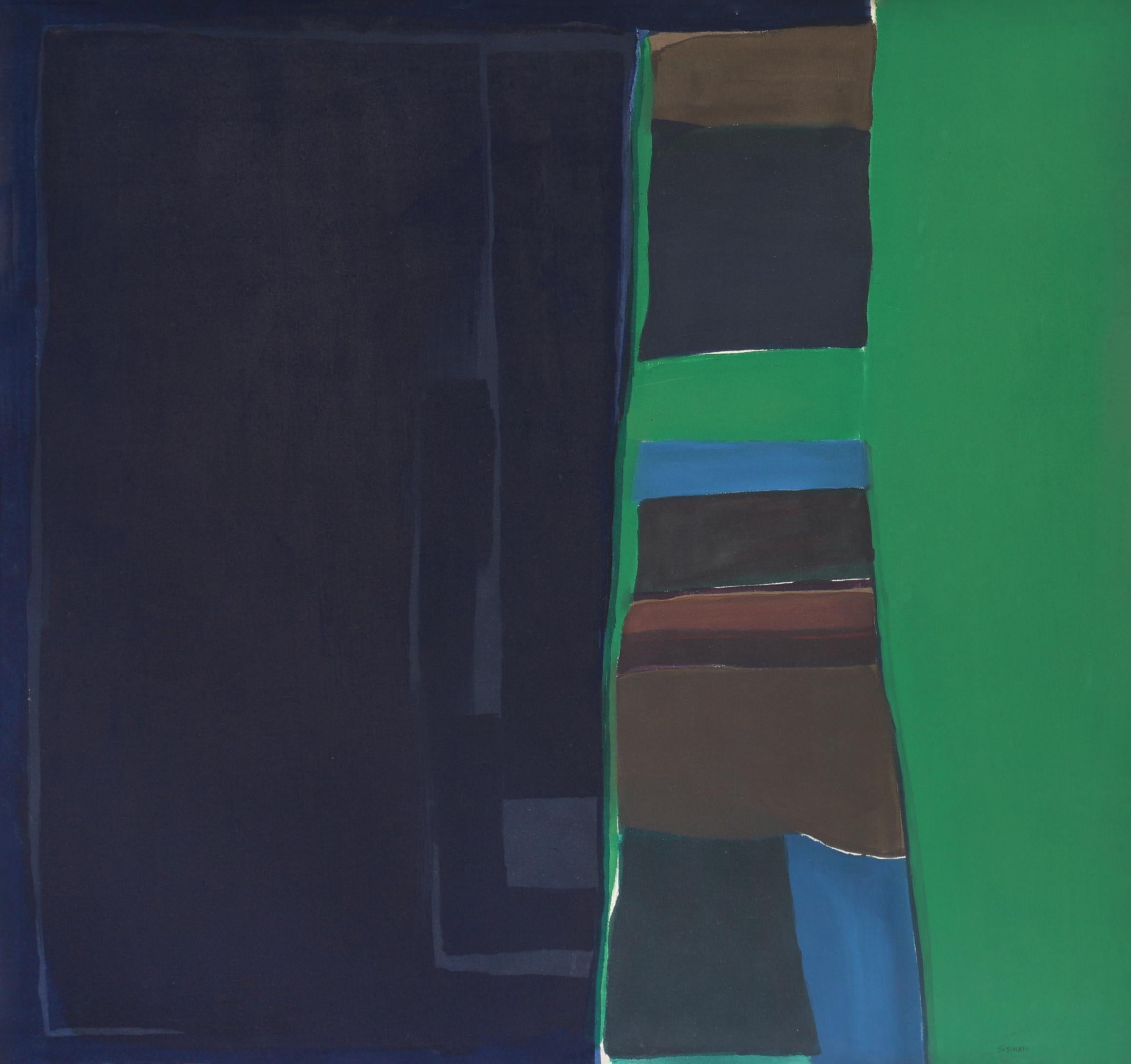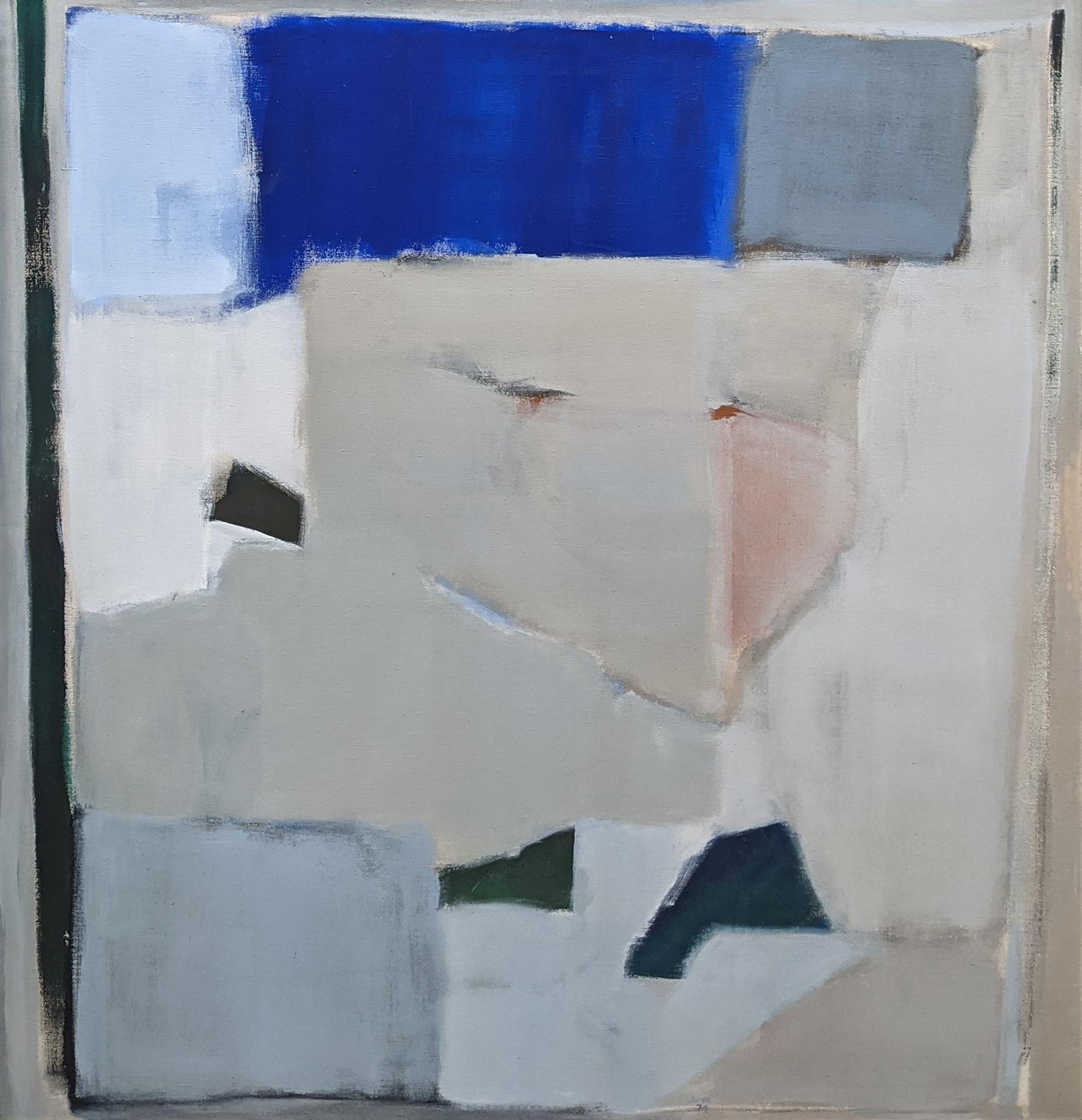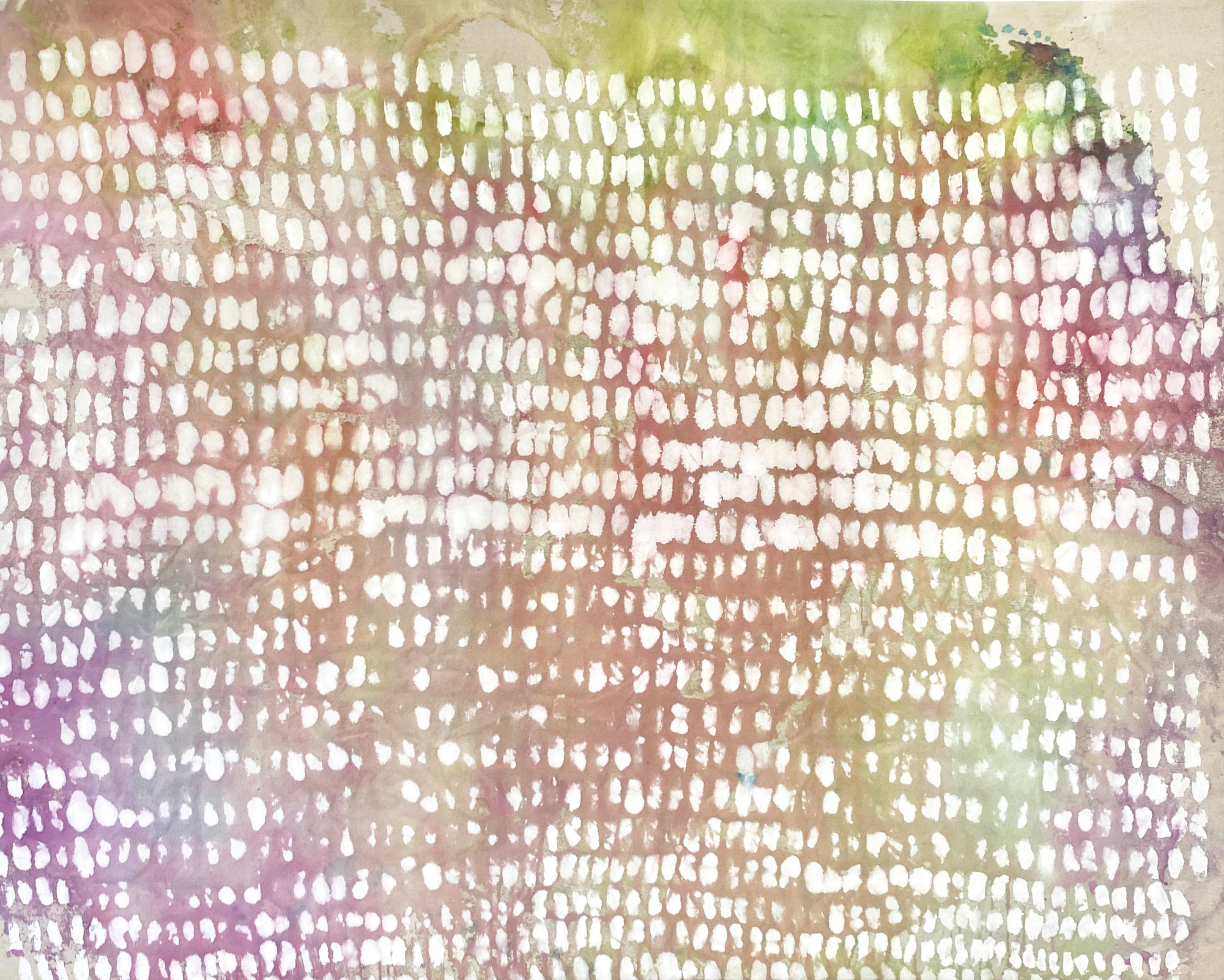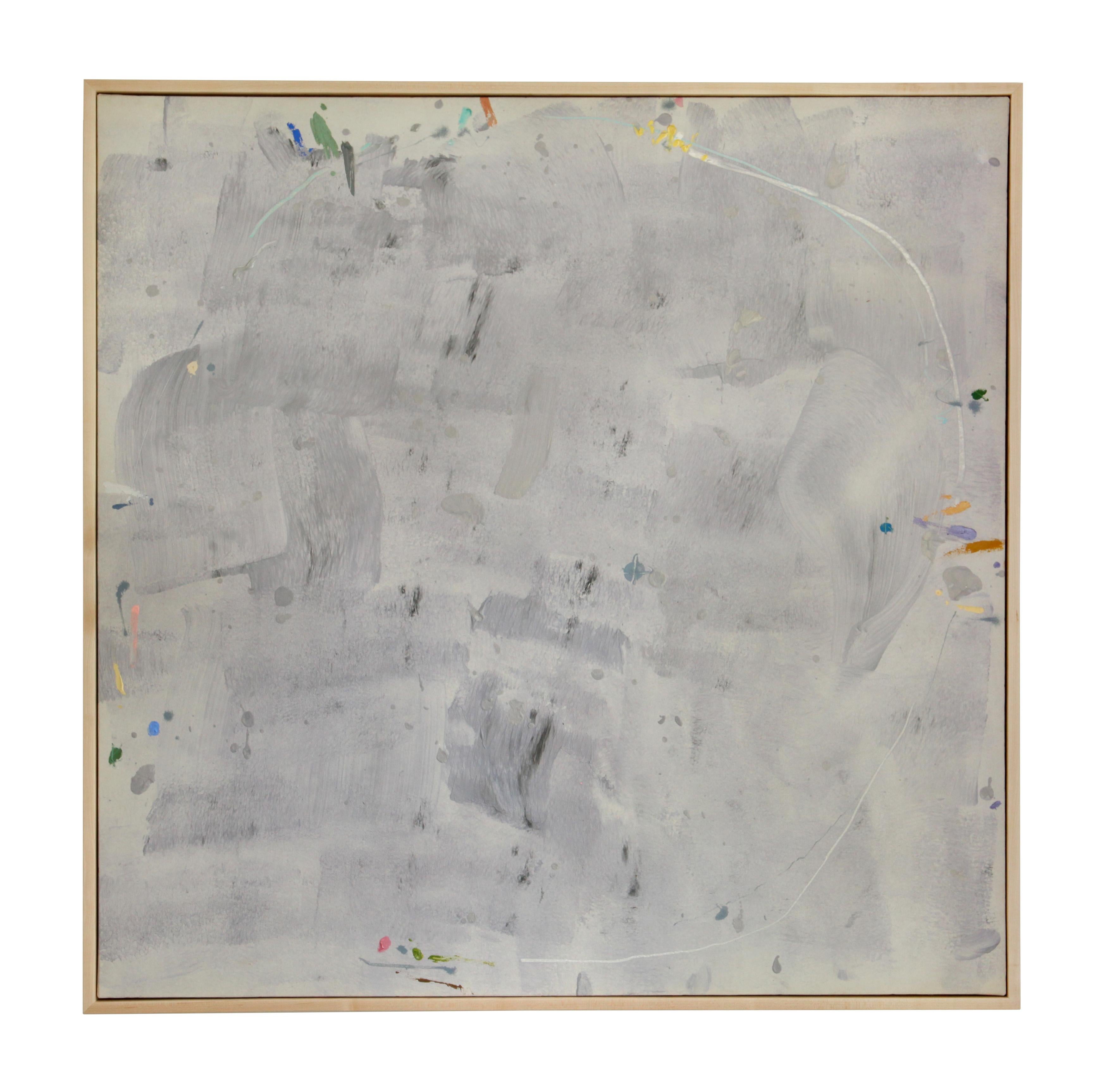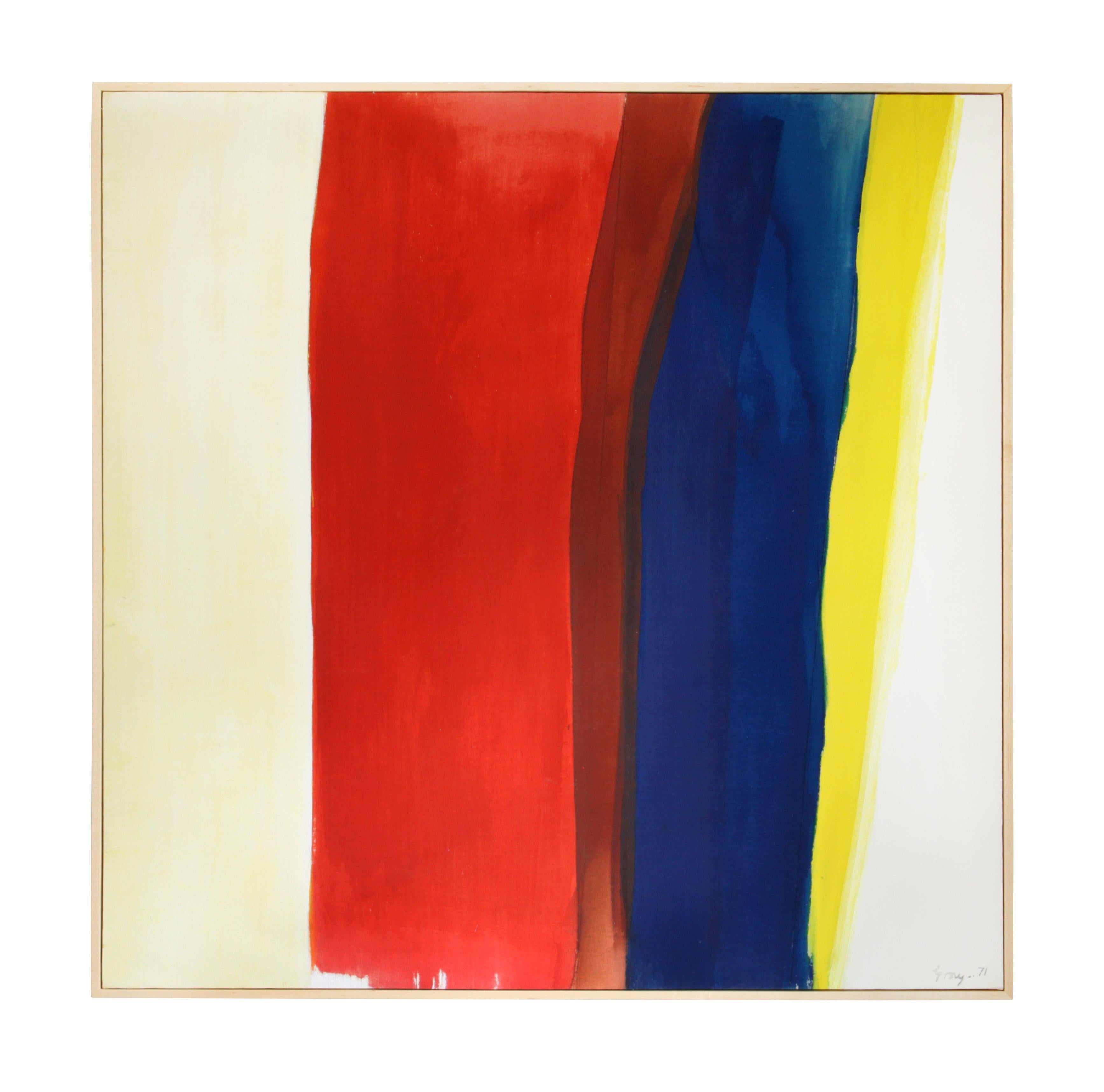Items Similar to "Eleven Thirteen, (Dancing Line Series), " Elliott Thompson, Color Field Abstract
Want more images or videos?
Request additional images or videos from the seller
1 of 4
Elliott Thompson"Eleven Thirteen, (Dancing Line Series), " Elliott Thompson, Color Field Abstract1972
1972
About the Item
Elliott Thompson
Eleven Thirteen, (Dancing Line Series), 1972
Signed, Elliott Thompson, dated, 2/72, and inscribed, Eleven Thirteen, on verso and again on stretcher
Acrylic on canvas
44 x 63 inches
Elliott Thompson’s career as an artist spanned more than six decades but only from about 1965 to 1980 was he at the center of the art world. In that period, he was one of the painters clustered around Washington, DC who rejected the painterly forms of abstract expressionism. Instead, he preferred impersonal hard-edged shapes on monochromatic fields that reinforced the flatness of the picture surface. Thompson’s work at this time represents some of the finest examples of this style that flourished during the 1960s and 1970s.
Thompson was born in Newport, Rhode Island in 1912 but he grew up in Washington, D.C. and spent most of his life in the area. He possessed a Scandinavian heritage and a middle-class background but he was only a mediocre student and dropped out of Briarly Hall Military Academy (Poolesville, MD) without a diploma. From 1929 to 1933, he joined the Navy and sailed the world through the worst part of the Great Depression.
After his enlistment ended in the Navy, Thompson worked at a variety of government jobs that eventually turned into a civil service career. While employed by the U.S. government, he took classes and received a BA in accounting from Ben Franklin University (later George Washington University). In 1939, he took a job with the Bureau of the Budget and for the next 20 years existed in a world of numbers and budgets. Meanwhile, Thompson’s personal life was in turmoil. He struggled with alcohol addiction and three failed marriages.
From 1953 to 1957, he lived in Paris while still working for the U.S. government. The five-year stay inspired him with a love for French culture and become an artist. Although he had never painted seriously, Thompson began studying art in Montparnasse in Paris at André Lhote’s academy. Thompson studied directly with Lhote, a Cubist painter who had an excellent reputation as a teacher. At this point, Thompson was still a part-time painter, concentrating on figurative scenes and still lifes.
In 1967, Thompson was 55 years old and there was no particular reason to predict a stellar artistic career for him. However, he now had more than 30 years of service with the federal government, and so was eligible for retirement. He decided to give up his position as a financial officer in the Supply and Maintenance Agency of the U.S. Army, and devoted himself to art on a full-time basis.
That same year, he began studying with Roy Slade at the Corcoran School of the Arts and Design, the school associated with the Corcoran Gallery of Art. Thompson made rapid progress with his painting. He abandoned realistic subject matter for non-figurative art and switched from oils to acrylics, lured by their faster drying time. He soon joined the faculty of the Corcoran and began exhibiting his geometric abstract canvases. By the 1970s, the long-time bureaucrat had become a critically acclaimed artist.
Even in his first efforts, Thompson’s approached painting as a kind of problem in measurement and organization, as befitting a man who had worked with numbers his entire life. His earliest paintings from 1967 to 1969 were based on the division of a square, mostly in black and white, or just white on raw canvas. Many of them were neat abstractions of repetitious forms assembled on a grid. A critic at one of his exhibitions described his work as “mathematical and sequential, formal, disciplined, austere.” Even when he began introducing color into his canvases in 1971, he continued to focus on pattern and repetition.
Thompson displayed his art in several group and solo shows from the late 1960s through the early 1990s. Between 1969 and 1973, his most prolific period, he had regular exhibitions at the Jefferson Place Gallery, a noted supporter of Washington Color School artists. In 1974, the Corcoran Gallery of Art presented a retrospective exhibit of his work, affirming his meteoric rise.
Because Thompson lived in Washington, DC at the time, he was often linked with members of the Washington Color School such as Gene Davis, Thomas Downing, Paul Reed, and Howard Mehring. In some ways, he did not fit comfortably in this category. Thompson came late to the movement and his earliest geometric abstracts were in black and white, eschewing color.
But Thompson did adopt a consciously impersonal approach to paint application. There was an absence of visible brushstrokes in Thompson’s work, and an emphasis on sharp composition. Each area was clearly defined. Instead of the broad gestures and the emotional mysticism so prized by abstract expressionists, Thompson emphasized formal elements such as lines and shapes. He never tired of this approach. In 1979, he began a major series of hard-edged geometric canvases based on the trapezoidal form.
However, by 1980, the aesthetic of hard-edged abstraction had fallen out of fashion among art critics. That year, one critic reviewed one of Thompson’s gallery shows by noting that Thompson “had with dogged loyalty remained true to his straight edge, his masking tape, his panels of flat, well-chosen colors.” Though he had only been painting seriously for 13 years, he was already 68 years old. Unlike many painters, he had never staked his life on an art career. Fame meant little to him. A fourth marriage in 1983 to a woman 38 years younger was a happy distraction. From 1984 to 1987, he lived and painted in a small village in southern France but his desire to paint or teach gradually faded away. In 1987, the couple returned to the United States and moved to northern Virginia. He gradually drifted into obscurity, dying in 2016 at age 103.
Elliott Thompson’s career as an artist spanned more than five decades but only from about 1965 to 1980 was he at the center of the art world. His hard-edge geometric abstracts were precise, impersonal, and devoid of almost any reference to the outside world. His best canvases offered viewers a meditative space where form, color, line, scale, and texture were almost all that mattered. He did not shine for long but he shined brightly.
- Creator:Elliott Thompson (1912 - 2016, American)
- Creation Year:1972
- Dimensions:Height: 44 in (111.76 cm)Width: 63 in (160.02 cm)
- Medium:
- Movement & Style:
- Period:
- Condition:
- Gallery Location:New York, NY
- Reference Number:1stDibs: LU1841211696842
About the Seller
5.0
Platinum Seller
These expertly vetted sellers are 1stDibs' most experienced sellers and are rated highest by our customers.
Established in 2021
1stDibs seller since 2022
59 sales on 1stDibs
Typical response time: 1 hour
- ShippingRetrieving quote...Ships From: Larchmont, NY
- Return PolicyA return for this item may be initiated within 3 days of delivery.
More From This SellerView All
- “Untitled.” Gabriele Evertz, Geometric Color Field, Bright RainbowLocated in New York, NYGabriele Evertz Untitled, 1993 Acrylic on canvas 48 x 48 inches Provenance: The artist Private Collection, Long island (acquired from the above) G...Category
1990s Color-Field Abstract Paintings
MaterialsCanvas, Acrylic
- "Nineteen" Thomas Downing, Purple Washington Color School Design, Shaped CanvasBy Thomas DowningLocated in New York, NYThomas Victor Downing (1928 - 1985) Nineteen, 1968 Acrylic on canvas 35 1/2 x 16 1/2 inches Signed on the reverse Provenance: Estate of the artist Henri Gallery, Washington, D.C. Private Collection, Washington, D.C. Thomas Downing was born in Suffolk, Virginia. In 1950, after graduating from Pratt Institute in New York City, he received a grant from the Virginia Museum of Fine Art to study in Europe. Upon returning from Europe, he settled in Washington, DC to teach at Catholic University. In 1954 Downing became a friend of Kenneth Noland, whose life drawing course he attended. From 1955 to 1956 Downing shared a studio with Howard Mehring, another artist who came to be identified with the Washington Color School. Downing had his first one-man show at the Washington Workshop Center for the Arts in 1959. That year, Downing, Mehring, and Betty Pajac founded Origio, a cooperative art gallery in Washington. In 1959 Downing first began using the small dot in his work, a motif he explored fully into the 1970s. In the early works colorful dots determined the structure of the painting in their size, position, and repetition within a grid. Often there was a sense of concentration and expansion of the composition from the center to the edge of the canvas, achieving a visual impression of expanding open space. Looking for the fusion between the grid and color, Downing eliminated overlapping dots in 1962. The dots arranged in grids seem to project from the canvas surface, giving the impression the color floats unrestricted by the square format of his paintings. Downing’s position in the Washington Color School came from his consistent approach to color. The canvas was the receptacle of color, on which Downing often worked in tonal modulations of a hue. Downing developed shaped canvases in 1966 as a structural solution to his deeper consideration of the “spatial definition” of color. After first working in a parallelogram shape, Downing next worked in chevron-shaped canvases that examined the illusionistic qualities of color. He exhibited these works in a solo exhibition at the Corcoran Gallery in 1966-1967 and later at the Allan Stone Gallery in New York in 1967. Downing’s second series of shaped canvases titled Folds were created in 1968. In the Fold series he discovered a new effect of relief and spatial depth within a flat work that could be enhanced by color. The projections and folding in the Fold paintings suggest the paintings exist in a world without gravity. Downing exhibited in a group show at Jefferson Place Gallery in 1960 and had his first solo exhibition there in the spring of 1961. Downing had solo exhibitions in New York at Allan Stone Gallery in 1962, 1967, and 1968. He also had solo exhibition in New York at Stable Gallery in September 1963 and January 1965. In the early 1970s Downing had regular solo exhibitions at the Pyramid Galleries in DC. In the 1960s Downing was included in important museum exhibitions, including: Post Painterly Abstraction at Los Angeles County Museum of Art, 1964 (Clement Greenberg curated and included three of Downing’s dial paintings); The Responsive Eye at the Museum of Modern Art, 1965; Colorists, 1950-1965 at the San Francisco Museum of Art, 1965; Systemic Painting at the Solomon R. Guggenheim Museum, New York, 1966; and Color Field Painting at the Philadelphia Museum of Art in 1970. Thomas Downing: Recent Paintings was held at the Corcoran Gallery of Art in December 1966 - January 1967. A solo exhibition of his paintings from 1962 to 1968 was held at the La Jolla Museum of Art then travelled to the Phoenix Art Museum in 1968. Downing had a solo exhibition at the Phillips Collection in 1985. Downing taught at the Corcoran School of Art and Design, Washington, DC from 1965 to 1968. There he was influential for the next generation of DC color...Category
1960s Color-Field Abstract Paintings
MaterialsCanvas, Acrylic
- "Burnt Orange Seams" Gerome Kamrowski, Color Field, Abstract ExpressionismBy Gerome KamrowskiLocated in New York, NYGerome Kamrowski Burnt Orange Seams, 1979 Acrylic on canvas 30 x 24 inches Gerome Kamrowski was born in Warren, Minnesota, on January 19, 1914. In 1932 he enrolled in the Saint Paul...Category
1970s Color-Field Abstract Paintings
MaterialsFoam, Mixed Media, Acrylic, Board
- "Night Road" Gerome Kamrowski, Abstract Expressionism Surrealism, Purple ImpastoBy Gerome KamrowskiLocated in New York, NYGerome Kamrowski (1914 - 2004) Night Road, 1966 Acrylic on canvas 58 1/4 x 96 1/4 inches Signed and dated Provenance: The Artist The Kamrowski Estate (by family descent in 2004) Exhibited: The Detroit Institute of Arts, Detroit, Michigan, 56th Exhibition for Michigan Artists, November 18 - December 31, 1966, no. 32, illustrated (Night Road was the winner of the "Phyllis King Weiner Memorial Prize" at this exhibition). Ann Arbor, University of Michigan Museum of Art, Gerome Kamrowski: A Retrospective Exhibition, August 30 - October 16, 1983, no. 70, illustrated. Tarpon Springs, Florida, Leepa-Rattner Museum of Art, St. Petersburg College, Gerome Kamrowski: An American Surrealist, September 8 - October 27, 2002, no. 23. Chelsea, Michigan, River Gallery, Gerome Kamrowski: 1914-2004, A Memorial Retrospective, October 30 - December 5, 2004. Gerome Kamrowski was born in Warren, Minnesota, on January 19, 1914. In 1932 he enrolled in the Saint Paul School of Art (now Minnesota Museum of American Art - MMAA), where he studied with Leroy Turner, and Cameron Booth. Both Turner and Booth had been students of Hans Hofmann, and were also associated with the Abstraction-Création group in Paris. It was from these peers that Kamrowski was introduced to a "kind of expressionist cubism." In 1933 Kamrowski was awarded a scholarship to the Art Students League, where he would study in New York under Hans Hofmann. Unfortunately, immigration problems had prevented Hofmann from assuming his post. Nevertheless, Kamrowski decided to remain in New York for a short time, to attend classes taught by George Grosz. After a few weeks, he returned to St. Paul, and found a position in the mural painting division of the Minnesota FAP/WPA (Works Progress Administration). In 1936 he contributed “Synthetic Cubist Style” frescoes in the Northrup Auditorium of the University of Minnesota. In 1937 Kamrowski went to Chicago to study under László Moholy-Nagy and Alexander Archipenko at the New Bauhaus (now Illinois Institute of Technology's Institute of Design). There he was exposed to new and interesting ideas regarding the role of nature in art and the "geometric basis of natural form". In 1938 Kamrowski received a Guggenheim fellowship to attend Hans Hofmann's summer school in Provincetown, Massachusetts. He then relocated to New York where he met William Baziotes. Together they shared a fascination in Surrealist automatic writing, and both artists explored its possibilities in their paintings. Kamrowski was particularly drawn to Surrealism's fundamental appeal of intuition over intellect. He was interested seeking a process that "binds all things together...a kind of cosmic rhythm". Throughout the late 1930s and early 1940s while living in New York, Kamrowski became an integral part of the emerging surrealists. In 1942, the artist Roberto Matta attempted to form a group of artists to investigate new applications for Surrealist methods. He invited Kamrowski, along with William Baziotes, Jackson Pollock, Peter Busa...Category
1960s Abstract Expressionist Abstract Paintings
MaterialsCanvas, Acrylic
- "Untitled, " Knox Martin, Abstract ExpressionismBy Knox MartinLocated in New York, NYKnox Martin (1923 - 2022) Untitled Signed to lower edge Acrylic and gold foil on canvas 9 x 9 inches Knox Martin (1923-2022) was an esteemed New York School painter. Knox Martin was born in 1923 in Barranquilla, Colombia. He was the son of the aviator, painter, and poet William Knox Martin, the first man to fly over the Andes Mountains. After serving in World War II, Knox Martin attended the Art Students League of New York on the G.I. Bill from 1946-1950, where he studied with Harry Sternberg, Vaclav Vytlacil, Will Barnet, and Morris Kantor. In 1954, Knox Martin's friend Franz Kline placed a painting of his in the Stable Gallery Annual. Charles Egan of the renowned Charles Egan Gallery saw Knox Martin's painting at the Stable Gallery and asked Martin to show his work in a one-man show for the tenth anniversary of the Egan Gallery. Since then, Knox Martin was a celebrated painter, sculptor and muralist. Knox Martin had an extensive exhibition record and his work is in museum, corporate and private collections worldwide. His two best-known murals in NYC are Venus and Woman with Bicycle...Category
Late 20th Century Abstract Abstract Paintings
MaterialsGold, Foil
- "Untitled, " Sherron Francis, Female Abstract Expressionism, White ImpastoBy Sherron FrancisLocated in New York, NYSHERRON FRANCIS (AMERICAN, B. 1940) Untitled, 1977 Acrylic on canvas 33 x 27 1/2 inches Signed, titled and dated on the reverse A reappraisal is long ...Category
1970s Abstract Expressionist Abstract Paintings
MaterialsCanvas, Acrylic
You May Also Like
- Blue and Green AbstractBy Claudia SisemoreLocated in Salt Lake City, UT"Blue and Green Abstract" by Claudia Sisemore, acylic on canvas, 43.5 x 46 inches, $4,800. "I have a vague idea of what I am going to paint. I...Category
1970s Color-Field Abstract Paintings
MaterialsCanvas, Acrylic
- Untitled, 1974By Claudia SisemoreLocated in Salt Lake City, UT"Untitled, 1974" by Claudia Sisemore, acylic on canvas, 58 x 56 inches, $7,200. Unframed. "I have a vague idea of what I am going to paint. I read that many artists are inspired by an idea before they begin their work and plan their approach and process based on that idea or muse. Others become inspired after they have begun working and watching colors, shapes and designs form. I basically belong the second group. Usually, after painting begins in a loose, free manner, I become excited by certain colors and patterns and continue from there." -Claudia Sisemore -- Caudia Sisemore says she was teaching English when artist David Chaplin (an equally popular and influential teacher) was at Weber and initially got her into landscape painting. “Then he took me to a show at the Art Barn and Lee [Deffebach] was showing there [with Don Olsen...Category
1970s Color-Field Abstract Paintings
MaterialsCanvas, Acrylic
- Untitled, 1975By Claudia SisemoreLocated in Salt Lake City, UT"Untitled, 1975" by Claudia Sisemore, acylic on canvas, 41.5 x 50 inches, $4,800. "I have a vague idea of what I am going to paint. I read that many artists are inspired by an idea before they begin their work and plan their approach and process based on that idea or muse. Others become inspired after they have begun working and watching colors, shapes and designs form. I basically belong the second group. Usually, after painting begins in a loose, free manner, I become excited by certain colors and patterns and continue from there." -Claudia Sisemore -- Caudia Sisemore says she was teaching English when artist David Chaplin (an equally popular and influential teacher) was at Weber and initially got her into landscape painting. “Then he took me to a show at the Art Barn and Lee [Deffebach] was showing there [with Don Olsen...Category
1970s Color-Field Abstract Paintings
MaterialsCanvas, Acrylic
- ephemeral vignette #03 - Colorful abstract stain painting, acrylic on raw canvasLocated in Philadelphia, PA'ephemeral vignette #03' acrylic painting by contemporary artist Elisa Niva, Acrylic on raw canvas 36 inches x 44 inches. Ephemeral is a large fluid pain...Category
2010s Color-Field Abstract Paintings
MaterialsCotton Canvas, Acrylic
- Spanish GhostBy Kikuo SaitoLocated in Austin, TXAcrylic on canvas. Signed, dated, and titled verso. 52.25 x 52.75 in. 54 x 54.25 in. (framed) Custom framed in a maple hardwood floater. Provenance Salander O’Reilly Galleries, Ne...Category
1980s Color-Field Abstract Paintings
MaterialsCanvas, Acrylic
- Captain CookBy Cleve GrayLocated in Austin, TXAcrylic on canvas. Signed and dated lower right, titled verso. 69 x 68.25 in. 70.5 x 70 in. (framed) Custom framed in a solid maple floater. Provenance Private Collection, Hilton ...Category
1970s Color-Field Abstract Paintings
MaterialsCanvas, Acrylic
